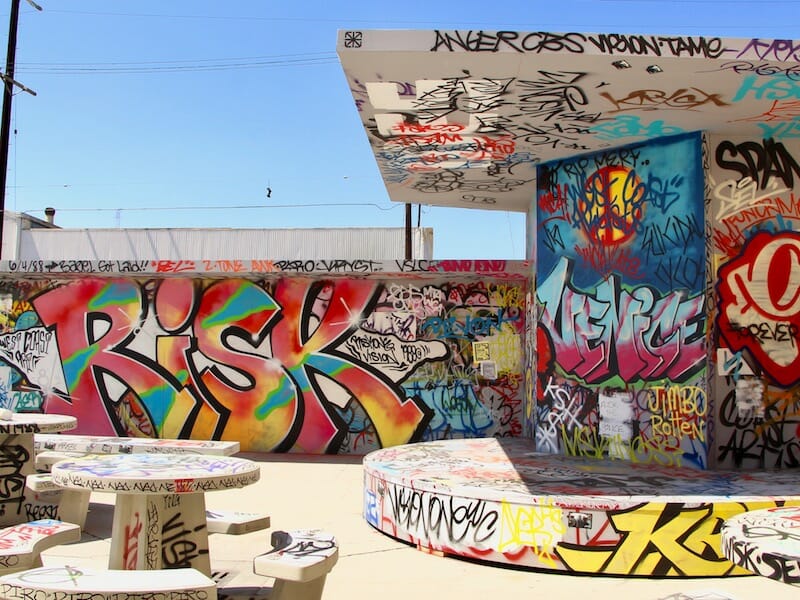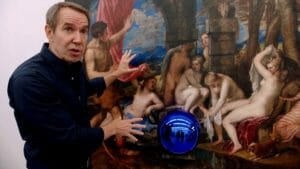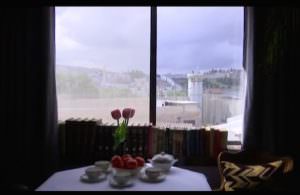‘Beyond the Streets,’ a Street Art Show, Ranges From Origins to Legacy
The show features over 100 artists, including stars like Basquiat, Banksy and Haring, as well as taggers from the format’s earliest days in the 1960s. Artist RISK's re-creation of a Venice skateboard pavilion is part of the "Beyond the Streets" show in downtown Los Angeles. (Jordan Riefe)
Artist RISK's re-creation of a Venice skateboard pavilion is part of the "Beyond the Streets" show in downtown Los Angeles. (Jordan Riefe)
What began as tagging or graffiti art in the 1960s, from individuals with names like Cornbread and “Wicked” Gary Fritz, has since blossomed into street art, making stars of people like Banksy, Keith Haring and Shepard Fairey, all part of the comprehensive new show “Beyond the Streets,” featuring over 100 international artists in Los Angeles’ Chinatown through July 6.
Curator Roger Gastman, who co-curated MOCA’s popular “Art in the Streets” show in 2011, also advised on the Oscar-nominated Banksy documentary “Exit Through the Gift Shop.” His movie “Wall Writers” is the definitive documentary on graffiti art of the 1960s and ’70s, and his connections throughout the street art community are vast and varied.
“Getting a group of artists like this together is, quite frankly, a huge pain in the butt,” Gastman sighs. “One thing I always have to remember is no matter how close a friend they are, or how long I’ve known them, all of these artists come out of an art form that is based on illegal activities. So they’re fucking paranoids and they’re always watching their back. That’s what they grew up learning to do ’cause they’re stealing spray paint, they’re climbing rooftops, they’re breaking into train yards and they’re making their marks.”
Photo Essay: “Beyond the Streets” Gallery
“Beyond the Streets” doesn’t just celebrate street art, a rebel format founded in vandalism that bypasses galleries, auction houses and museums to appeal directly to the public; the new show celebrates the format’s legacy, its roots and its fruits—direct from the artists’ studios.
“Nothing that’s in here is street art. Street art is on the street,” Fairey says about a format more defined by context than any other. Part of it dies when placed in a gallery, which is why a studio practice becomes essential to paying the bills. Some, like Fairey, maintain both a studio and street practice, taking commissions like his “RFK” and “Peace Tree” murals in Koreatown or “wheatpasting” the streets with his ubiquitous “Obey” posters.
“The idea that capitalism’s going to ruin everything—it’s one thing if the lure of money means somebody will no longer make public works because they could be spending time making canvases that will sell, but I think there are people who are deft at supporting themselves with their fine art and supporting their public art but without transitioning away from public art,” Fairey offers. “I know I’m one of those people. I have more and larger-scale public art because I’m not living hand-to-mouth anymore.”
For those who cannot afford to attend some fancy art school, street art can provide an avenue into a seemingly impenetrable profession. “The only barrier to entry is if you’re fearful. If you have courage, you’re in,” Fairey says. “In a way, that democratizes things.”
After 25 years of painting on walls, Jason Revok began a studio practice in 2010 and spent four years in Detroit making assemblages from items he found on the street. “That practice was a deliberate kind of move to distance myself from painting,” he says. Revok counts as a primary influence on 1970s painter of NYC subways, Futura, whose work hangs in the same gallery. “I was never interested in re-creating the work I did on the street in the studio,” Revok adds. “So that’s why I moved away from painting for a long time.”
Returning to L.A. marked a return to painting. Massive curvy-shaped canvases inspired by Robert Rauschenberg are the result. Revok hand-cranks an oversize Spirograph of his own invention, which applies a decorative border of pale blue, pink and white loops that overlap.
The husband-and-wife team of Dabs and Myla (DabsMyla) met in art school after Dabs spent most of his teen years running with a graffiti crew in Melbourne, Australia. Their installation consists of three whimsical, colorful pop murals surrounded by hundreds of artificial flowers. Placed in the street, such a work would quickly succumb to the elements, although the duo currently has two murals on display in Hollywood. For the past nine years their focus has been studio work as well as high-profile projects—like designing the logo and stage for the 2015 MTV Movie Awards. Though they frequently do street art abroad, they abstain in L.A. because a vandalism arrest would jeopardize their applications for citizenship.
A few steps away from their work is a massive mural by an artist who never worked in the street, Takashi Murakami, whose irreverent, playful cartoon figures are inspired by artists who did. A two-sided canvas, Murakami’s piece hangs in an open cylinder with a wall of flame consuming graffiti tags on the inside and the gaping maw of a psychedelic animal on the outside.
Banksy painted a piece especially for the show, in which a Basquiat-like figure is harassed by cops. Other artists in the show who were inspired by the movement include actor/photographer Dennis Hopper and Devo co-founder and film composer Mark Mothersbaugh.
In a gallery set off from an expansive and light-filled chamber, artist Randall Harrington stands in a shadowy space where a large bomb casing is laid out, part of his ironic comment on the aftermath of Hiroshima.
“If you put it on the back of a military truck and move it around in the street, it would be considered street art,” jokes Harrington, who has frequently collaborated with street artists but doesn’t identify as one. A look inside through the tail end of the bomb provides a glimpse at a diorama where an old-fashioned movie drive-in screens “Godzilla.” “I thought I’d love to look inside a bomb and see what’s in there, but to look in and see something different,” he says.
Something different is exactly what Southern California native Patrick Martinez had in mind when he started painting walls at Pasadena’s Art Center College of Design. He began by trying to only manipulate paint, and it blossomed into street art. “I don’t know about that word. I like ‘graffiti’ more ’cause I think the entry point for a lot of the guys, it was the medium,” says Martinez, whose neon art spells out phrases like “Brown Owned” and “America is for Dreamers.”
For Martinez, the term “street art” is “like what they did in the 2000s, with wheat pasting,” he says, grasping for a definition. “So that lives on the street. Whatever lives in the galleries and museums, I don’t know what you’d call that. For me, it is a buzzword in the 2000s and they used it like, ‘Oh yeah, this guy’s a street artist.’ And I think a lot of these people come from a pure place and that was graffiti, ’cause it was direct.” Reaching back even further, he adds, “It was like cave drawings. This is just an evolution of that. Everyone’s different, but I think a lot of people will tell you that they came from a pure place of marking things.”
Your support matters…Independent journalism is under threat and overshadowed by heavily funded mainstream media.
You can help level the playing field. Become a member.
Your tax-deductible contribution keeps us digging beneath the headlines to give you thought-provoking, investigative reporting and analysis that unearths what's really happening- without compromise.
Give today to support our courageous, independent journalists.





You need to be a supporter to comment.
There are currently no responses to this article.
Be the first to respond.